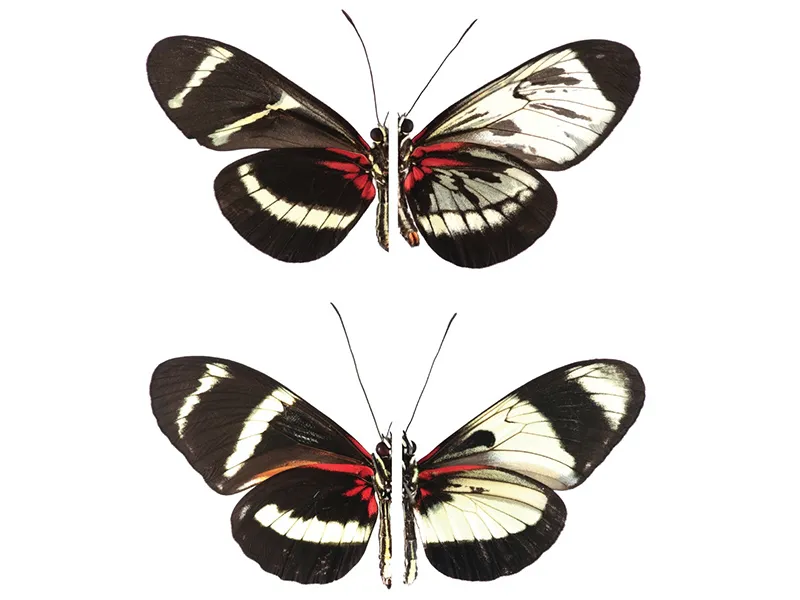What Butterflies’ Colorful Wing Patterns Can Teach Us About Evolution
Smithsonian scientists used genetically-engineered butterflies to learn that evolution can take a different path to achieve the same thing
:focal(1342x733:1343x734)/https://tf-cmsv2-smithsonianmag-media.s3.amazonaws.com/filer/37/4d/374dc8b2-b3d7-4f58-a55c-428a77448a20/butterfly.jpg)
At first, Carolina Concha and her fellow researchers at the Smithsonian Tropical Research Institute worried that every mutant butterfly would die. They were attempting to deactivate a crucial wing-patterning gene known as wntA, and they aimed to make this genetic change not in just one variety of butterfly, but in 22 types. Fortunately, the mutant insects developed normally, from egg to caterpillars to chrysalises to full-fledged butterflies. And when the butterflies finally unfurled their wings, they contained a lesson in evolution—just like navigating a car through a web of city streets, there are many routes to get to the same evolutionary destination.
Concha says the research, newly published in Current Biology, investigates several broad evolutionary questions, among them, “How is convergent evolution achieved?”
When different species independently develop traits that closely resemble each other, that’s convergent evolution—it means that the same evolutionary solution boosted their chances of survival. Butterflies provide good case studies of this phenomenon because they’re impressive mimics. Some types of butterflies can produce cyanide-like toxins, making them very unpleasant prey. “A bird will eat a butterfly and learn, after one, or two, or three experiences, not to eat it anymore,” explains Concha. The bird remembers that butterfly from its wing patterns and avoids it. Other species, poisonous and harmless alike, that live in the same area have evolved lookalike wings for protection.
“Basically, we were asking whether the butterflies use the same developmental networks to color and map their wings in different species,” Concha says.
To investigate this big evolutionary question, researchers at STRI and partner institutions focused on something miniscule: the scales on butterfly wings, so small the naked eye can’t distinguish them. The scales, overlapping “like tiles on a roof,” as Concha describes them, form the black-and-brightly-hued patterns adorning butterfly wings. In the butterfly genus Heliconius, known for their varied wing appearance, four genes strongly influence wing pattern, including the “pre-patterning gene” wntA.
Wings start out as wing disks towards the end of the caterpillar stage of metamorphosis. Pre-patterning genes like wntA activate and communicate with different molecules and genes, more or less outlining the master plan for wing pattern. Eventually, these signals determine the identity and position of each wing scale, which develop colorless in the chrysalis at first before pigments get made. (Yellow, white and red are the first colors to emerge; black and darker pigments appear later.)
/https://tf-cmsv2-smithsonianmag-media.s3.amazonaws.com/filer/6b/5e/6b5e0f6e-eb3c-4d06-9444-889562aa8148/heliconius-poster.jpg)
To better understand how wntA shapes wing pattern under normal conditions, Concha and her team had to create mutants, deactivating the gene using CRISPR, a genetic editing tool that was introduced in 2012.
In an interview with Vice, biologist Michael Perry from the University of California, who has studied the genetic basis of butterfly wing color, noted the innovative technique. “Eight or nine years ago, I would’ve never believed you if you said that it would be possible to make targeted mutations in 12 different species of Heliconius.” But with CRISPR, the STRI researchers reared more than 100 modified butterflies from 12 species and 10 sub-types.
By disrupting the wntA gene in the mutant butterflies, researchers wanted to see how wing pattern changed. If two different species with mirror-image wings under normal conditions both had the gene knocked out, would the mutated patterns look similar across species, or would the genetic mutation lead to different end results for separate species?
As it turned out, diverse species responded differently to the deactivated gene. Scientists noticed what Concha describes as “a boundary shifting,” often color bleeding into areas that had previously been black. Normally, Heliconius hewitsoni and Heliconius pachinus, whose habitats overlap in western Costa Rica and Panama, share three yellowish-white stripes and a central flare of red. But in the wntA mutants, H. hewitsoni had off-white coloring spread almost throughout its forewing and developed a patch of gray in its hindwing. H. pachinus, in contrast, still had a bold black stripe through its forewing and no gray.

The discrepancy told the scientists that wntA has evolved to act differently in these distantly related species. If evolution is a maze where the exit is optimal survival, it’s like the species figured out two separate twisting-turning pathways through the genetic labyrinth to arrive at the same color pattern—a result Concha calls “a bit unexpected.” “People would more frequently expect that they would share a common pathway,” she says, especially because these creative genetic pathways cropped up in a relatively short time span; the species diverged between 14 and 10 million years ago.
The researchers then zoomed in, using a microscope that creates close-ups 15,000 times bigger than their actual size, to look at the texture of individual scales. Different color scales have unique topography, and this closer look confirmed, Concha says, “the gene is controlling the identity of that scale.”
In these particular butterflies, evolution had happened more speedily and less predictably than scientists tend to expect. In the Current Biology paper, Concha and her co-authors note that evolution is too complicated for generalizations. Still, she says, if evolution took two starkly different paths to pattern near-identical butterfly wings, “It could happen more than we think.”

